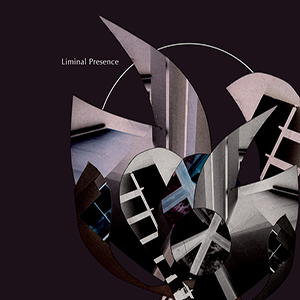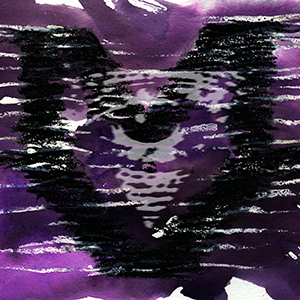 With these two new releases recorded and released in 2019, Stephen Petrus's long running noise/death industrial/ambient/whatever project continues to be productive and constantly evolving, demonstrating his wide array of influences and talents. Here are two distinctly different sounding discs, one a shared release with fellow dark synth fan David Reed (also a member of Nightmares), and the second featuring Murderous Vision in duo configuration with the addition of Jeff Curtis on bass. Each of the discs are remarkable, and exemplify just how much versatility there is in Petrus's work.
With these two new releases recorded and released in 2019, Stephen Petrus's long running noise/death industrial/ambient/whatever project continues to be productive and constantly evolving, demonstrating his wide array of influences and talents. Here are two distinctly different sounding discs, one a shared release with fellow dark synth fan David Reed (also a member of Nightmares), and the second featuring Murderous Vision in duo configuration with the addition of Jeff Curtis on bass. Each of the discs are remarkable, and exemplify just how much versatility there is in Petrus's work.
Live Bait Recording Foundation
Liminal Presence, with Envenomist is billed not as a split nor collaboration, and while that sounds somewhat confusing, it actually makes sense upon listening.The disc is bookended by two collaborative pieces with Petrus and Reed working together, and the two trade off on the eight songs in-between.It is never difficult to tell who is responsible for what song, but their personal styles complement one another quite well and the complete product is all the richer for it.
The general pattern though is that the Murderous Vision pieces tend to be the noisier ones, featuring more sustained, constant passages, while the Envenomist ones are cold and spectral, with open mixes and shifting layers of complex synth sounds.For example, Petrus' "Time Dilation" is built on a foundation of expansive electronic drone, with some distorted swells and an echoing, heavy reverb bit of percussion.It is heavy, but also structured in a very conventional way.This is paired with Reed’s "Sleepwalker":ghostly synth bits rise and fall like subtle waves, creating a dynamic that is not overly oppressive, but nicely spacious and ambient.
This alternating pattern continues throughout, with pieces from Murderous Vision such as "Parasomnium," featuring the addition of fragments of voice samples (a nice touch for the whole sleep/dream theme of the album), heavy bass rumbles and buzzsaw electronics.Things do get a bit harsh here and there, but in general the dynamics ensure the sound stays in the dream-like mode throughout.Later on "Valine" he piles on the layers of electronics, from an initial sputtering synth and later a surprisingly melodic synth progression taking the focus of the otherwise hushed layers.
On the other half, Envenomist emphasizes the drift elements of the album’s sound, with his work occasionally resembling tense film cues.Throughout "Fathomless Light" he slowly nudges things along, punctuating the wide open mix with some shrill electronic scrapes.The ghostly landscape becomes peppered with extremely complex and nuanced synthesizer bits, contrasting the more austere arrangements.For "Servant" he envelops the sound in a blanket of heavy reverb, giving an appropriate dream-like haze.
Even on the two collaborative pieces that open and close the album, each artist’s personal style is distinct."Zeitgeber" opens the disc, with Reed’s synths shifting and passing through like floating in dark water, with the occasional outburst, as Petrus provides the backing, noisier segments and churning static."Luminiferous Aether" is the disc’s ending note, with Reed's passing swells mixed with Petrus's sustained, noisier textures blended together, nicely functioning as the concluding section of the work.

At a different end of the spectrum, Surface Bone is a five song EP featuring Petrus alongside Jeff Curtis, who supplies bass guitar to the electronics.Consisting of four studio recordings and a live performance of those same songs (on the CD only), it showcases Murderous Vision at its most industrial.Right from the onset of "Ancestral Remains" the mood is obviously different from Liminal Presence.Buzzing, churning noise is immediate, with percussion and rhythms fleshing everything else out.The addition of Curtis’s bass is what really sets it apart, however.With the combination of the dense rhythms and his bass tone and performance, the final product resembles a harsher, murky take on the Cure's "Carnage Visors."
The bass is also a prominent part of "Surface Bone," but within the heavier noise and hollow space it is more of a sinister piece of ambient music.Drums (or drum programming) also feature heavily in "A Thought That Shatters Teeth," and Curtis’s bass is processed with a massive amount of distortion.Between the pounding rhythms and grinding, dirgey distortion, it is doomy as hell, but extremely dynamic and varied.Unsurprisingly the Live in LA performance does not present anything drastically different, just the same basic sounds from the studio material but in a looser, more chaotic environment."A Thought That Shatters Teeth" stands out, however, with the live setting pushing the bass into the mix even harder.
Even though both of these discs were recorded in 2019, both the mood and the style of both differ drastically from one another.With David Reed on Liminal Presence, Stephen Petrus channels the sounds of dreaming and sleep, from open, drifting spaces to lurking, electronic menace and nightmarish creep.With Jeff Curtis on the half live/half studio Surface Bone, chaos reigns but grounded by heavy rhythms and a greater nod to industrial and goth sounds that surely has influenced the project since the beginning.Even with these two rather different styles, there is a distinct feel consistent to both, which only further drives home the point that Murderous Vision has been, and continues to be, among the top tier artists in the world of heavy, dark electronics.
Read More

